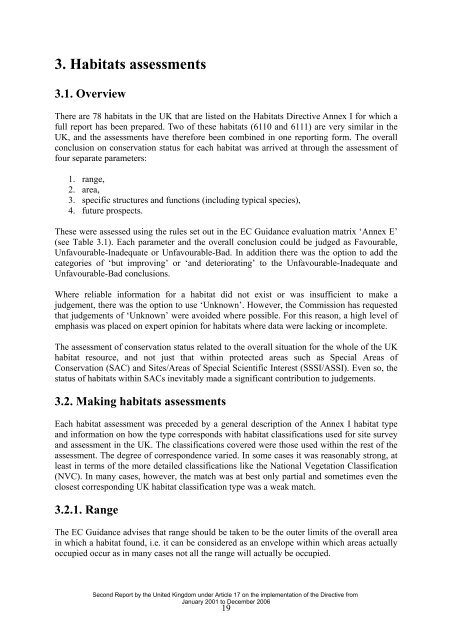Assessing Conservation Status: The UK Approach - JNCC
Assessing Conservation Status: The UK Approach - JNCC
Assessing Conservation Status: The UK Approach - JNCC
Create successful ePaper yourself
Turn your PDF publications into a flip-book with our unique Google optimized e-Paper software.
3. Habitats assessments<br />
3.1. Overview<br />
<strong>The</strong>re are 78 habitats in the <strong>UK</strong> that are listed on the Habitats Directive Annex I for which a<br />
full report has been prepared. Two of these habitats (6110 and 6111) are very similar in the<br />
<strong>UK</strong>, and the assessments have therefore been combined in one reporting form. <strong>The</strong> overall<br />
conclusion on conservation status for each habitat was arrived at through the assessment of<br />
four separate parameters:<br />
1. range,<br />
2. area,<br />
3. specific structures and functions (including typical species),<br />
4. future prospects.<br />
<strong>The</strong>se were assessed using the rules set out in the EC Guidance evaluation matrix ‘Annex E’<br />
(see Table 3.1). Each parameter and the overall conclusion could be judged as Favourable,<br />
Unfavourable-Inadequate or Unfavourable-Bad. In addition there was the option to add the<br />
categories of ‘but improving’ or ‘and deteriorating’ to the Unfavourable-Inadequate and<br />
Unfavourable-Bad conclusions.<br />
Where reliable information for a habitat did not exist or was insufficient to make a<br />
judgement, there was the option to use ‘Unknown’. However, the Commission has requested<br />
that judgements of ‘Unknown’ were avoided where possible. For this reason, a high level of<br />
emphasis was placed on expert opinion for habitats where data were lacking or incomplete.<br />
<strong>The</strong> assessment of conservation status related to the overall situation for the whole of the <strong>UK</strong><br />
habitat resource, and not just that within protected areas such as Special Areas of<br />
<strong>Conservation</strong> (SAC) and Sites/Areas of Special Scientific Interest (SSSI/ASSI). Even so, the<br />
status of habitats within SACs inevitably made a significant contribution to judgements.<br />
3.2. Making habitats assessments<br />
Each habitat assessment was preceded by a general description of the Annex I habitat type<br />
and information on how the type corresponds with habitat classifications used for site survey<br />
and assessment in the <strong>UK</strong>. <strong>The</strong> classifications covered were those used within the rest of the<br />
assessment. <strong>The</strong> degree of correspondence varied. In some cases it was reasonably strong, at<br />
least in terms of the more detailed classifications like the National Vegetation Classification<br />
(NVC). In many cases, however, the match was at best only partial and sometimes even the<br />
closest corresponding <strong>UK</strong> habitat classification type was a weak match.<br />
3.2.1. Range<br />
<strong>The</strong> EC Guidance advises that range should be taken to be the outer limits of the overall area<br />
in which a habitat found, i.e. it can be considered as an envelope within which areas actually<br />
occupied occur as in many cases not all the range will actually be occupied.<br />
Second Report by the United Kingdom under Article 17 on the implementation of the Directive from<br />
January 2001 to December 2006<br />
19
















